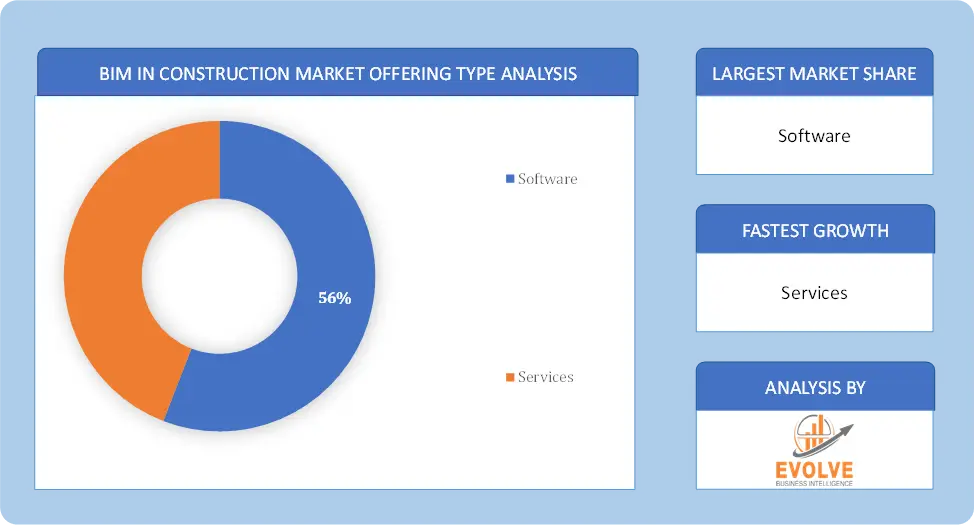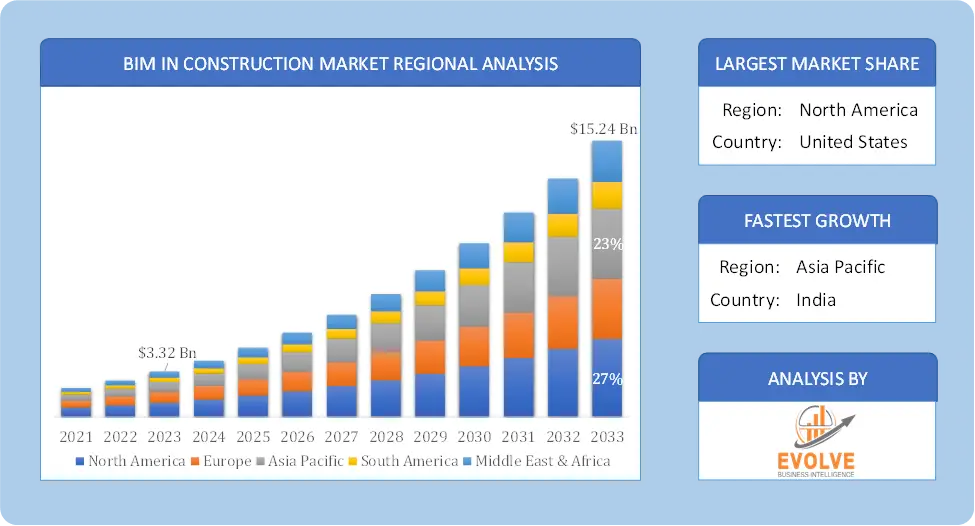BIM in Construction Market Overview
The BIM in Construction Market Size is expected to reach USD 15.24 Billion by 2033. The BIM in Construction Market industry size accounted for USD 3.32 Billion in 2023 and is expected to expand at a compound annual growth rate (CAGR) of 13.47% from 2023 to 2033. Building Information Modeling (BIM) in the Construction Market refers to the use of digital technologies to create and manage a digital representation of the physical and functional characteristics of a construction project. BIM encompasses the entire lifecycle of a building, from planning and design to construction, operation, and maintenance.
The adoption of BIM in the construction market is driven by the need for improved efficiency, reduced costs, and better project outcomes. It also supports sustainability efforts by enabling more accurate energy modeling and reducing material waste. BIM is increasingly becoming a standard practice in construction, particularly in complex projects and large-scale developments.
Global BIM in Construction Market Synopsis
The COVID-19 pandemic had a significant impact on the BIM (Building Information Modeling) in the Construction Market. The pandemic accelerated the adoption of digital technologies, including BIM, as the construction industry sought ways to continue operations despite restrictions and lockdowns. Remote working and collaboration became essential, making BIM a crucial tool for project management and communication. With travel restrictions and social distancing measures, traditional on-site meetings and inspections became challenging. BIM facilitated virtual collaboration, enabling teams to work together on the same project from different locations, thus maintaining project timelines and efficiency. The pandemic caused delays and disruptions in construction projects due to supply chain interruptions, labour shortages, and site closures. BIM helped mitigate some of these challenges by allowing better project planning, simulation of construction sequences, and resource management. The pandemic highlighted the importance of resilience and adaptability in the construction industry. As a result, BIM is expected to play an even more critical role in future construction projects, with a continued focus on digital collaboration, sustainability, and efficient project management.
BIM in Construction Market Dynamics
The major factors that have impacted the growth of BIM in Construction Market are as follows:
Drivers:
Ø Technological Advancements
The continuous development of BIM software and tools, including the integration of artificial intelligence (AI), machine learning, and cloud computing, is making BIM more accessible and user-friendly. These advancements enhance the capabilities of BIM, making it a more attractive option for construction firms. BIM reduces the likelihood of errors, rework, and project delays by providing accurate and detailed digital representations of construction projects. This leads to significant cost and time savings, making BIM an essential tool for optimizing construction processes. BIM is essential for prefabrication and modular construction as it allows precise design and planning. The growing trend toward these construction methods, driven by their efficiency and sustainability benefits, is boosting the demand for BIM.
Restraint:
- Perception of High Initial Costs and Data Security Concerns
Implementing BIM requires significant upfront investment in software, hardware, and training. Small and medium-sized construction firms may find these costs prohibitive, making it challenging to adopt BIM technologies. As BIM involves the sharing of large amounts of sensitive project data among multiple stakeholders, there are concerns about data security and privacy. The risk of cyberattacks and data breaches can be a significant restraint, particularly in highly sensitive projects.
Opportunity:
⮚ Integration with Advanced Technologies
BIM’s integration with cutting-edge technologies such as artificial intelligence (AI), machine learning, Internet of Things (IoT), and big data analytics offers significant opportunities. These technologies can enhance BIM’s capabilities, enabling predictive modeling, real-time monitoring, and data-driven decision-making, leading to smarter and more efficient construction processes. Offering BIM as a service (BIMaaS) is an emerging business model where companies provide BIM-related services, such as modeling, analysis, and data management, on a subscription or project basis. This model lowers the entry barrier for smaller firms and provides flexibility for companies that do not have the resources to implement BIM in-house.
BIM in Construction Market Segment Overview
By Offering Type
 Based on Offering Type, the market is segmented based on Software and Services. The Software segment dominant the market. Software comprises digital tools and platforms that enable users to create, manage, and manipulate three-dimensional (3D) models and associated project data. These software solutions are central to the BIM workflow and play a crucial role in facilitating collaboration and project management. Design and modeling software tools are used for creating 3D models and designs of buildings and infrastructure.
Based on Offering Type, the market is segmented based on Software and Services. The Software segment dominant the market. Software comprises digital tools and platforms that enable users to create, manage, and manipulate three-dimensional (3D) models and associated project data. These software solutions are central to the BIM workflow and play a crucial role in facilitating collaboration and project management. Design and modeling software tools are used for creating 3D models and designs of buildings and infrastructure.
By Applications
Based on Application, the market segment has been divided into Buildings, Industrial, Civil Infrastructure, Oil & Gas and Others. The Industrial segment dominant the market.
By Project Life Cycle
Based on Project Life Cycle, the market segment has been divided into Preconstruction, Construction and Operations. The Preconstruction segment dominant the market. Preconstruction applications of BIM involve its use in the initial phases of a building or infrastructure project, ranging from conceptual design through detailed planning and preparation before construction begins. BIM aids in creating 3D models for conceptual design, helping stakeholders visualize the appearance and layout of projects. BIM software can generate accurate cost estimates, helping project stakeholders develop budgets and financial plans.
Global BIM in Construction Market Regional Analysis
Based on region, the global BIM in Construction Market has been divided into North America, Europe, Asia-Pacific, the Middle East & Africa, and Latin America. North America is projected to dominate the use of the BIM in Construction Market followed by the Asia-Pacific and Europe regions.
 BIM in Construction North America Market
BIM in Construction North America Market
North America holds a dominant position in the BIM in Construction Market. North America is one of the leading regions in BIM adoption, driven by a mature construction industry and strong technological infrastructure. The U.S. government and various state agencies have been increasingly mandating the use of BIM for public projects, particularly in infrastructure and large-scale developments. The region’s focus on sustainability, efficiency, and innovation also supports the widespread use of BIM. Canada is similarly progressive, with industry guidelines and government initiatives promoting BIM adoption.
BIM in Construction Asia-Pacific Market
The Asia-Pacific region has indeed emerged as the fastest-growing market for the BIM in Construction Market industry. Asia-Pacific is a rapidly growing market for BIM, with China and Japan leading the way. In China, the government’s push for modernization and the development of smart cities is driving BIM adoption. Japan has a well-established construction industry that is increasingly integrating BIM, particularly in large-scale and infrastructure projects. BIM adoption in India and Southeast Asia is in the early stages but is growing rapidly due to urbanization, infrastructure development, and government initiatives. However, challenges such as the high cost of implementation and a lack of skilled professionals may slow the pace of adoption in these regions.
Competitive Landscape
The global BIM in Construction Market is highly competitive, with numerous players offering a wide range of software solutions. The competitive landscape is characterized by the presence of established companies, as well as emerging startups and niche players. To increase their market position and attract a wide consumer base, the businesses are employing various strategies, such as product launches, and strategic alliances.
Prominent Players:
- Autodesk Inc.
- Asite Solution
- Beck Technology Ltd.
- Bentley Systems Incorporated
- AVEVA Group Plc.
- Dassault Systemes
- Hexagon AB
- Nemetschek SE
- Pentagon Solution Ltd.
- Trimble Ltd.
Key Development
In November 2022, Bentley Systems Incorporated announced new capabilities of its iTwin Platform, significantly extending the scope and interoperability of infrastructure data that engineering firms and owner-operators can use to create and leverage digital twins in design, construction, and operations workflows.
In September 2022, Autodesk Inc. announced a suite of new capabilities across Autodesk Construction Cloud, making it easier for construction project teams to use and maximize the value of BIM from the office to the field. The enhancements provide all stakeholders with immediate access to model data and information, empowering team members to simplify workflows and make critical decisions faster.
Scope of the Report
Global BIM in Construction Market, by Offering Type
- Software
- Services
Global BIM in Construction Market, by Application
- Buildings
- Industrial
- Civil Infrastructure
- Oil & Gas
- Others
Global BIM in Construction Market, by Project Life Cycle
- Preconstruction
- Construction
- Operations
Global BIM in Construction Market, by Region
- North America
- US
- Canada
- Mexico
- Europe
- UK
- Germany
- France
- Italy
- Spain
- Benelux
- Nordic
- Rest of Europe
- Asia Pacific
- China
- Japan
- South Korea
- Indonesia
- Austalia
- Malaysia
- India
- Rest of Asia Pacific
- South America
- Brazil
- Argentina
- Rest of South America
- Middle East & Africa
- Saudi Arabia
- UAE
- Egypt
- South Africa
- Rest of Middle East & Africa
| Parameters | Indicators |
|---|---|
| Market Size | 2033: $15.24 Billion |
| CAGR | 13.47% CAGR (2023-2033) |
| Base year | 2022 |
| Forecast Period | 2023-2033 |
| Historical Data | 2021 |
| Report Coverage | Revenue Forecast, Competitive Landscape, Growth Factors, and Trends |
| Key Segmentations | Offering Type, Application, Project Life Cycle |
| Geographies Covered | North America, Europe, Asia-Pacific, Latin America, Middle East, Africa |
| Key Vendors | Autodesk Inc., Asite Solution, Beck Technology Ltd., Bentley Systems Incorporated, AVEVA Group Plc., Dassault Systemes, Hexagon AB, Nemetschek SE, Pentagon Solution Ltd. And Trimble Ltd |
| Key Market Opportunities | • Integration with Advanced Technologies • BIM as a Service (BIMaaS) |
| Key Market Drivers | • Technological Advancements • Cost and Time Savings |
REPORT CONTENT BRIEF:
- High-level analysis of the current and future BIM in Construction Market trends and opportunities
- Detailed analysis of current market drivers, restraining factors, and opportunities in the future
- BIM in Construction Market historical market size for the year 2021, and forecast from 2023 to 2033
- BIM in Construction Market share analysis at each product level
- Competitor analysis with detailed insight into its product segment, Government & Defense strength, and strategies adopted.
- Identifies key strategies adopted including product launches and developments, mergers and acquisitions, joint ventures, collaborations, and partnerships as well as funding taken and investment done, among others.
- To identify and understand the various factors involved in the global BIM in Construction Market affected by the pandemic
- To provide a detailed insight into the major companies operating in the market. The profiling will include the Government & Defense health of the company’s past 2-3 years with segmental and regional revenue breakup, product offering, recent developments, SWOT analysis, and key strategies.








